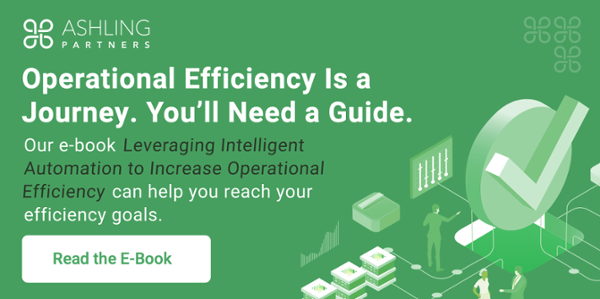Can you accurately define your company’s operational efficiencies or lack thereof? It’s a large and complex topic, impacting every department or line of business. Assessments and internal audits can tell you a lot, but are you getting the full story? Is your bias clouding your judgment, or are you and your team simply not experts?
No matter where you are on the spectrum of operational efficiencies, organizations often need a trusted partner to evaluate where they are and how to get where they want to be.
So when is the right time to engage a partner? And what kind of partner should you seek?
Why Operational Efficiencies Are Vital to Business Health
Every business wants to be more efficient, but what does that really mean? It depends on your industry, processes, customer needs, and goals. However, fundamentally, achieving operational efficiency should measurably improve a process.
When you have efficiency, you have less waste—whether that’s less waste of time, money, people, or materials. The whole point of operational efficiency is to be leaner. For any workflow involving manual efforts, workarounds, disorganization, or anything else that eats at efficiency, there is a way to improve. Most of the time, automation initiatives are the answer.
First, you have to determine if you’re moving the meter on efficiency, which means having a way to measure it accurately.
How Are You Measuring Operational Efficiencies?
To understand anything, you must be able to measure it. When it comes to operational efficiencies, there are many important metrics. What’s most vital are those measurements you take after you improve a process or workflow with the aim of making it more efficient:
- Did it decrease the time spent on the task?
- Are fewer resources needed now?
- Is the process more accurate?
- Are there any cost savings associated with the first three metrics?
If you’ve attempted to optimize efficiencies with automation with no measurable results, then it’s time to call in the experts. With this type of guidance, you can eliminate your inherent bias.
Finding the Right Partner to Evaluate Operational Efficiencies and Help You Achieve Them
If your internal team and strategies need a boost, it’s time to tap an expert. There are many consultants in the space, so it is important to consider specific criteria as you explore options. Evaluating partners on these key components is important to ensure you have the right match.
Their Standard Process
You’ll want to inquire about a company’s approach to operational efficiency through automation. First, find out if they even have one because some consultancies just go with the flow. Something as strategic as operational efficiency needs a proven operating model behind it. In our process, we use the 4 As as that model:
- Advisory: We assess current state processes, drive discovery through a variety of means to include benchmarking, and deploy foundational IA pillars. Then we make recommendations for automation use cases and create a roadmap across people, processes, and technologies.
- Automation: Next, we design the automation solutions and conduct the build. Testing and iterations occur to fine-tune the automation.
- Analytics: We build analytics and dashboards from your automaton log data to drive improvements. We also use process mining to uncover other automation opportunities.
- Artificial Intelligence: Finally, we layer in AI, which elevates simple automation to intelligent automation using machine learning, vision recognition, speech recognition, and natural language processing.
Their Technology Toolbox
To execute automation capabilities into your processes, your partner will need access to the best tools for robotic process automation (RPA) and intelligent automation (IA).
A robust toolbox should include RPA platforms, optical character engine (OCR) solutions, natural language generation (NLG) capabilities, and AI.
Our solutions include end-to-end intelligent automation solutions. With these capabilities, your partnership with us is all about outcomes.
Their Ability to Support You No Matter Where You Are on the Automation Journey
Your partner should be able to work with you at every phase. For example, we break it down into:
- Plan: Plotting the vision and strategy for automation
- Build: Designing the automation and testing it
- Run: Launching the automation and managing it
- Measure and improve: Tracking all metrics and learning from them to ensure continuous improvement
Their Expertise and Track Record
In assessing expertise and experience, ask these questions:
- Is the company deeply rooted in automation solutions and supporting companies to scale solutions across the enterprise?
- Do they have case studies and proof of their successes?
- Can they easily leverage their experience to evaluate your operations?
- Do they offer custom solutions versus cookie cutter?
Our experience includes over 1000 processes automated, 500,000 hours saved, and $40 million in cost savings. As a result, we are able to remain outcome-driven for our clients.
Their Change Management Strengths
Ultimately, you want to know if your partner will help your organization embrace change. Working toward operational efficiency and implementing automation are significant enterprise changes. The change can be painful and slow, but a great partner will help you navigate this so that it’s as seamless as possible and accepted by your team.
Ashling Partners Believes in True Partnerships to Accelerate Efficiency
If you’re ready to take the next step toward operational efficiency, start by reading our e-book Leveraging Intelligent Automation to Increase Operational Efficiency. In it, we share our knowledge, processes, expertise, and technology approaches. Find out what it’s like to work with us on your journey.



